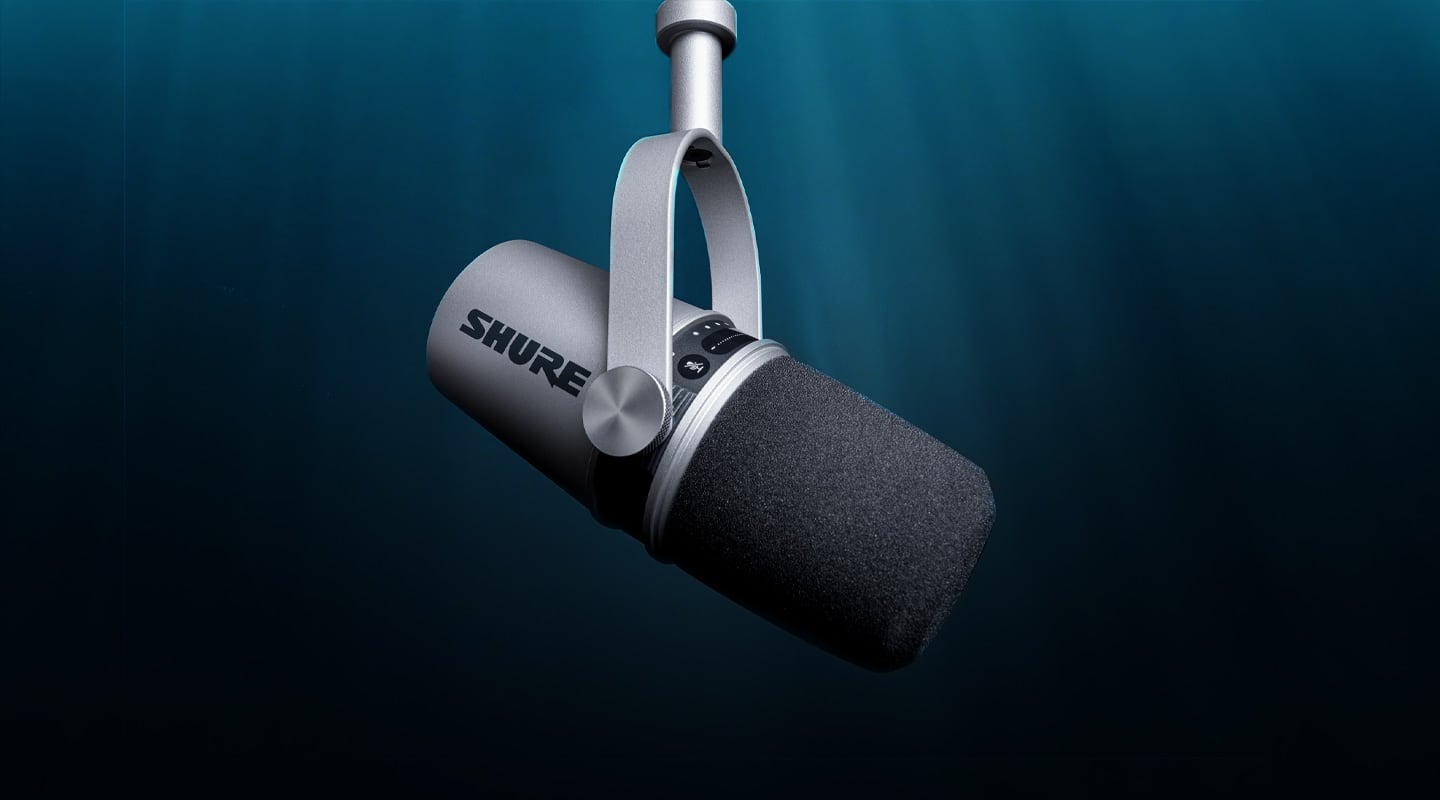
Shure MV7
The world needed a budget-friendly response to the venerated Shure SM7B – the MV7 is that and much more.
USB Podcasting Microphone
Not many people have bad things to say about the Shure SM7B, although its price tag positions it slightly beyond the ‘budget-friendly essentials’ category. For this reason, the idea of a cheaper SM7B-style mic from Shure has always been appealing.
With the new MV7, Shure has not only answered this call but gone the extra mile by adding a USB interface, headphone output, built-in processing and app control – all on top of an SM7B-inspired dynamic microphone design, available to you for A$500. Got your attention yet?
The Shure MV7 is a dynamic cardioid microphone with a slightly tubbier form factor than its big brother but otherwise many visual similarities. It’s got the versatile Y-mount, the slip-on foam windshield, and comes in the same black finish (or silver, if you prefer). Given the SM7B’s popularity in radio and broadcast, it’s no surprise Shure is marketing the MV7 as an all-in-one podcasting USB mic, perhaps as a response to what’s hot in the market right now as much as the mic’s inherent strength.
UNBOXING
In the box is the MV7 itself, already attached to the Y-mount; two generous 3m USB cables (Micro-B to USB-C and Micro-B to USB-A); and a nicely written Quick Start Guide.
Unlike a typical USB mic, the MV7 is also designed for ‘proper’ studio use, hence the XLR output for connection to a preamp or interface. Just under the mic’s windshield is a half-circle ring with touch pads to control its USB functions, similar to what you find on Shure’s MVi and MV51. The touch strip adjusts the internal preamp’s gain (0-36dB), headphone level or monitor mix, with a visual indication from the LEDs running its length. Toggle through the strip’s function by pressing the Mic/Headphone button to its right – press and hold for two seconds to adjust monitor mix. On the other side is a mic mute button, and you can lock the touch pads by pressing and holding both buttons for two seconds. Personally I prefer the tactile feedback of a knob or dial over a touch strip but it works fine. Note: the strip deactivates when the mic is in Auto Level Mode. More on that later.
The XLR output, 3.5mm headphone output and USB Micro-B connector all sit on the back of the MV7. As with most USB mics, monitoring via the headphone output will be at zero latency.
When using the MV7 as a USB mic, Shure recommends using it with the ShurePlus Motiv app to access all of its capabilities. Download it from the Shure website on your desktop or mobile and connect your MV7 via USB cable. The Motiv app runs in two modes – Auto Level or Manual. Switch over to Manual for easy control of gain, mute, monitor mix, limiter, EQ, and compression. The four EQ options include flat, HPF, presence boost, and both HPF and presence boost. Compression options are simply Off, Light, Medium or Heavy. ShurePlus Motiv also lets you save and recall Custom Presets based on settings you’ve dialled in.
NEED TO KNOW

NATURAL DYNAMICS
I was dazzled by the first recording I made with the MV7. Spoken word is conveyed very naturally. The lack of hype or exaggeration makes a voice sound ‘real’ in a way that’s easier for the listener to connect with, and it’s undoubtedly a sonic nod to the beloved attributes of the SM7B. Sibilance is kept under control thanks to the dynamic capsule and the Y-mount helps keep it unobtrusive in front of your face. The mic does a fantastic job rejecting noise and room sound thanks to its tight pickup pattern. The MV7 is fairly sensitive to proximity, and the closer you get the more pronounced plosives become. Back off about 10cm for a more consistent level and less pops and booms.
Speaking of consistent levels, the MV7 uniquely offers an Auto Level Mode which acts as a real-time gain setter which adaptively responds to the loudness of your voice. Select ‘Auto Level’ instead of ‘Manual’ in the ShurePlus Motive app and you’re presented with a few basic controls – Mic Mute, Monitor Mix, Mic Position (Near or Far) and Tone (Dark, Natural or Bright). It’s all you need for a set-and-forget approach, and the automatic gain does a commendable job maintaining a consistent level, even when I tried to surprise it with sudden bursts of SPL.
Shure’s choice of both EQ and compression settings are very tasteful and clearly designed to enhance spoken word. Dialling up heavy compression with a presence boost/HPF resulted in a convincingly forward and punchy ‘hard sell’ sound while lighter compression settings gave more transparent level control well suited to conversational recordings.
‘NORMAL’ MODE
The MV7’s XLR output basically shouts ‘I’m not a toy’ and it’s what I love most about this mic. Shure hasn’t relegated the MV7 to the consumer USB mic bracket. That XLR output lets audio engineers see the MV7 as a studio-ready addition to any mic arsenal.
Does it perform? It Shure does (sorry).
Jokes aside, the Shure logo plus the ‘SM7B-inspired’ marketing raised my expectations of the MV7’s sound and it doesn’t disappoint. Vocals are its strong suit and recorded tracks took both real-time interface DSP and plug-in processing nicely. A high shelf boost helps it sit nicely in a thick mix and I can see the MV7 as a great option for rock or hip hop vocals where a dirtier, meatier sound is the go.
Personally, I couldn’t resist tracking acoustic guitar through it. Again it yielded a very natural, ‘true to the room’ sound not unlike a ribbon mic. However, it also revealed the MV7’s slight lack of detail in the highs, as well as a noise floor which becomes noticeable with soft sources like fingerpicked playing. Probably not your go-to instrument mic but it’ll get you out of a bind, if necessary.
SEVEN SIGNS OF HAPPINESS
There’s no doubt the Shure MV7 ticks all the podcast boxes: simple USB setup, warm and natural tone, minimal sibilance, great off-axis and noise rejection, flexible positioning, and easy EQ and compression enhancements on tap. The ability to go between a one-cable USB setup and a fully-fledged studio gig is invaluable and markedly broadens the MV7’s appeal. If I got to keep this review model, I’d use it everyday.
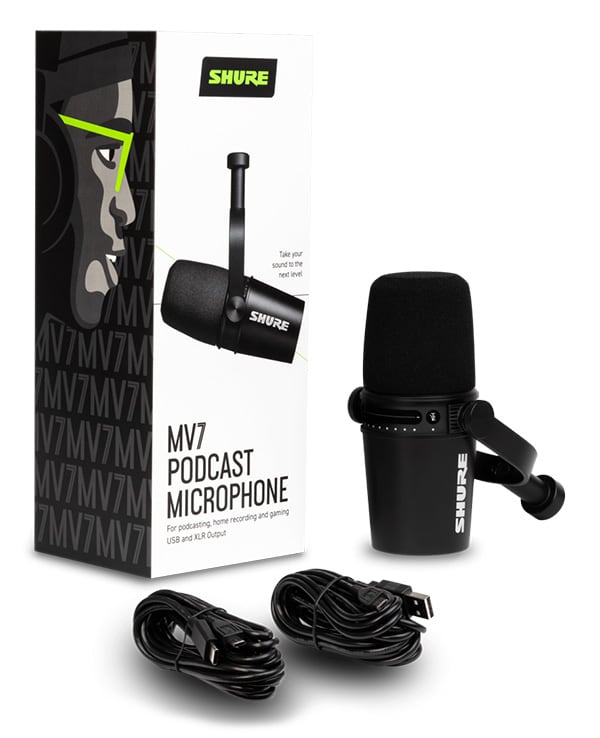




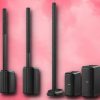












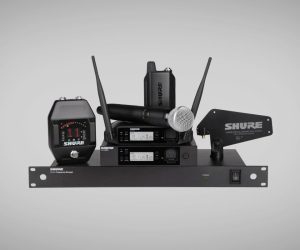
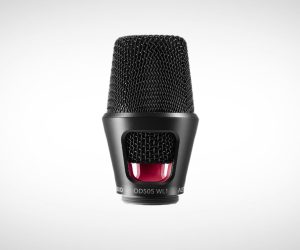






Hi 🙂
I am listening to your review on YouTube recorded with this Mic, which I’ve purchased already, but my recordings are so low in volume that I don’t know what I’m doing wrong?! I was recording in Audacity software. What kind of software were you using to record this video?? I was considering buying a preamp because of it in order to use it over the XLR cable. I need it for voice-over work only. PLEASE HELP! :)))